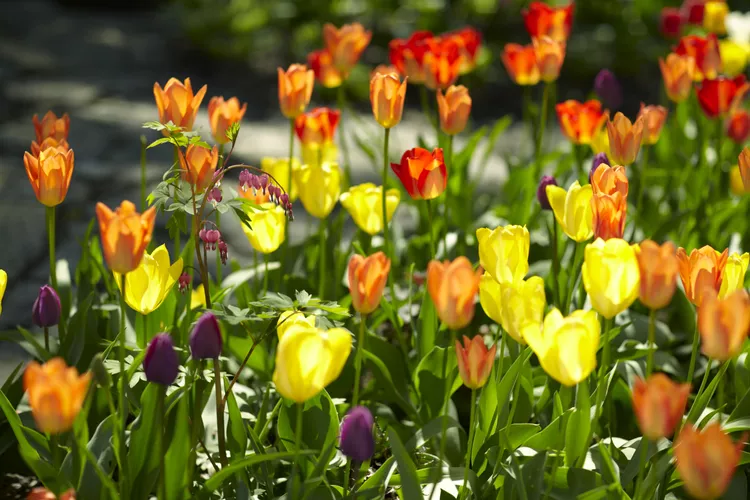Say you forgot to plant that sack of tulip bulbs you bought last fall. Can you plant tulips in the spring or not? While spring-blooming bulbs are typically planted in the fall for a reason, that doesn't mean it's too late to get your tulip bulbs planted if you missed the ideal window. Find out how to plant tulips in spring so they'll still bloom for you.
Why Tulips Are Planted in Fall
Like many other bulbs, including daffodils, crocus, and garlic, tulips need a period of cold called vernalization. These plants require a certain amount of exposure to cold temperatures to trigger the formation of features like flowers and bulbs. Without vernalization, your tulips will grow but not likely bloom. You'll get a vegetative tulip this year–all foliage and no flowers. However, they will likely bloom the next year after they've had a chance to get vernalized over the winter.
For gardeners in cooler climates, planting tulips in the fall takes advantage of natural conditions to provide the 10-14 weeks of cold temperatures tulips need to produce flowers. But gardeners in locations without cold winters need to buy chilled bulbs or chill them in the refrigerator.
Tips for Planting Tulips in the Spring
So, can you plant tulips in the spring? The quick answer is…it depends. All is not lost if you missed the fall planting window for whatever reason. Don't just abandon those bulbs, especially if you spent some serious cash on designer tulips. Here are a few things to try.
Plant Early
If you've got a bag or two of bulbs left from fall sitting around, you may be able to plant them now, depending on your climate. Some areas receive cool temperatures over winter, but the ground doesn't freeze or only freezes in a thin layer.
If that's you, get out there and get those bulbs in–the earlier, the better. While this is more of a winter planting than a springtime activity, it may yield a few blooms. Take advantage of a mid-winter thaw to get those tulips in the ground.
Buy Pre-Chilled Bulbs
Search for pre-chilled tulip bulbs online, and you'll find plenty of selections. If you don't already have bulbs sitting around, this is the way to go. Knowing that many gardeners love tulips but don't live in areas with the necessary cold temperatures, many suppliers will chill bulbs in coolers and ship them in time for late winter planting.
Even if you don't live in a warm locale, you can take advantage of this and order pre-chilled bulbs. Once they arrive, plant them immediately or store them in a cool–but not freezing–location until ready to plant. These bulbs are often sold as "ready for forcing," but they'll work fine if planted outdoors instead.
Chill Tulip Bulbs Yourself
If you've got space in your refrigerator, you can mimic the natural vernalization process. Place the tulip bulbs in the refrigerator in a brown paper bag or a mesh bag like onions are sold in.
Don't chill bulbs in the same refrigerator as your fruit and vegetables. Many fruits and some veggies give off ethylene gas as they ripen, and that gas will cause problems with your tulip bulbs. If you have a spare fridge in the garage or a mini-fridge in the den, it might be just the ticket. An unheated garage that remains above freezing but below 45°F can also work.
Plant Them Anyway
Tulip bulbs in otherwise good condition–not mushy or soft, not dried out and crispy–should still be planted. While they won't have been chilled enough so likely won't flower this spring, they will still sprout and make foliage, recharging the bulb for next year's blooming.
This is a great way to take advantage of clearance bulbs on sale in spring for deep discounts. Unique colors and varieties that go for sky-high prices in fall are frequently sold for a song in late winter to clear inventory. Go ahead and grab that sale bag and plant them in the ground for next year.
If you want tulips that return reliably year after year, look for species tulips rather than hybrid varieties. Species tulips may be less showy but they tend to last longer.
Force Tulips Indoors
Tulip bulbs also can be forced, which means tricking the bulbs into growing and flowering when they otherwise wouldn't. You'll still need to buy pre-chilled bulbs, which you would plant in containers. Forcing tulip and other bulbs into early bloom is a great way to bring a little springtime cheer into your house, even if it looks like a winter wonderland outside.




















